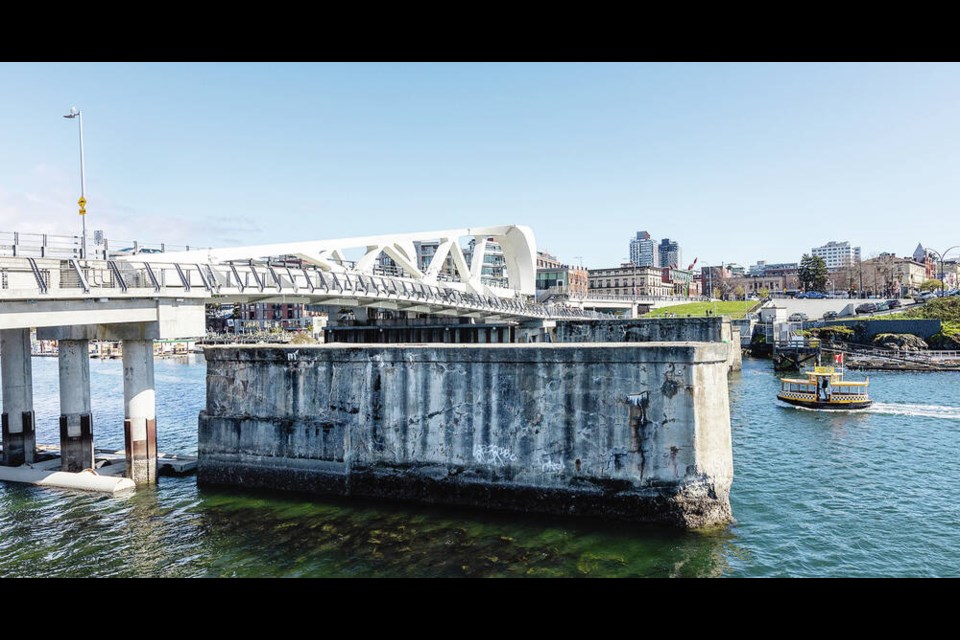Large ship strikes on Victoria’s main bridge are highly unlikely because of strict federal transport rules and safely measures in place around the span, says a structural engineer.
Jonathan Huggett, who was the project manager of Victoria’s Johnson Street Bridge, said Tuesday the Victoria Harbour master requires front and rear tugs to guide all large ships and barges passing through Victoria Harbour and under the bridge. Their weights are restricted to 8,000 tonnes and speeds are closely monitored.
Like others around the world Tuesday, Huggett watched news of a massive cargo ship that lost power and struck a bridge in Baltimore, Maryland, causing the 2.6-kilometre span to collapse.
“My first reaction was ‘where are the tugs, and why was it travelling so fast,’ ” Huggett said in an interview.
The structural engineer said 100,000-tonne ships like the one in Baltimore, even after losing power, “still have enormous energy and there’s very little you can do to stop it … it’s better to deflect it because it takes less effort.”
He said the type of shipping in Victoria is vastly different. The traffic includes smaller ships and ferries going in for repairs at Point Hope Maritime shipyard and barges carrying aggregates to a cement plant or scrap steel from a recycling yard on the Upper Harbour.
But bridges here have been hit.
Huggett said since the new Johnson Street Bridge officially opened on March 31, 2018, there have been only two “minor incidents,” where a tug passing under without the span raised miscalculated its height and damaged a mast with telecom equipment, and a barge travelling out that banged off a pontoon deflector on the north side. Both operators paid for the minor damages.
The old Blue Bridge suffered ship impacts in 1958 and 2011.
Fendering, or deflection structures to protect the bridge, was an issue as overall costs ballooned to more than $105 million for the new Johnson Street Bridge.
The concrete piers from the old Blue Bridge were used to build fenders on the south side of the bridge. On the north side, pilings were put in to support small pontoon fendering to bump off-course vessels back into the bridge channel.
The fendering performed as it should three years ago when a barge made contact, said Huggett, adding the fender was damaged but replaced at the operator’s cost.
Huggett said Victoria Harbour is small and most shipping destinations like Point Hope and the aggregates yards are in close proximity.
In 2015 the city paid for simulator exercises at the Pacific Maritime Institute in Seattle for all possible shipping traffic under different scenarios in relation to the bridge. “We even tried to crash into the bridge, but couldn’t,” said Huggett.
But he said the best safety method is the reliance on tugs to move vessels in and out. “If someone shows up without a tug, they won’t open the bridge. It’s saying go away and get that sorted,” said Huggett.
Huggett said some of the largest ships at Point Hope Maritime’s shipyard are B.C. Ferries vessels. The company used its own ship master and supervisors to bring the vessels in
There is no fendering around the Point Ellice Bridge on Bay Street, but the channel is wider for ship and barge navigation.
A city hall spokeswoman said the city manages the operation of the Johnson Street Bridge, lifting the bridge as required to allow passage for large vessels that cannot safely pass under.
She said there is “close co-ordination” between the city, Transport Canada and harbour users, and whether approaching the bridge from the north or the south, large vessels are required to schedule bridge lifts and verify approach procedures.
Traffic is cleared from the bridge and the span is lifted before the approaching vessel passes a “go point,” the city said. At all times during approach and passage, the vessel operator is under radio or cellular communication with the city’s on-site bridge operator.
>>> To comment on this article, write a letter to the editor: [email protected]




